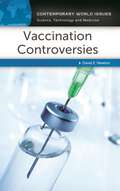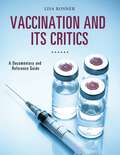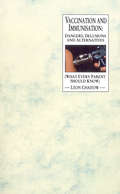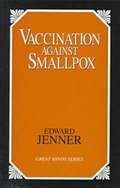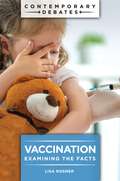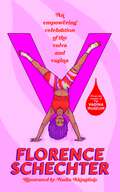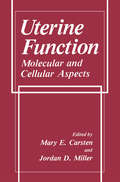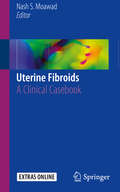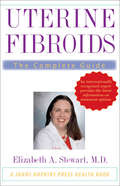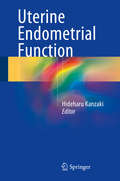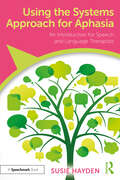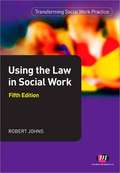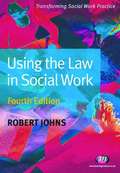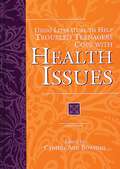- Table View
- List View
Vaccination Controversies: A Reference Handbook (Contemporary World Issues)
by David E. NewtonWhy is there such an active and ongoing resistance to mandatory vaccination? This book examines why vaccination as a public health measure continues to be highly controversial.Objections to mandatory vaccination are widespread in the world today. Rather than being a new development, such objections have existed since vaccinations were first introduced. This book provides complete coverage of the history and background of vaccination issues in the United States and around the world, along with a detailed examination of the issues related to the use of vaccination today, and supplies readers with the necessary information to consider if the potential benefits of vaccination outweigh the risks.Vaccination Controversies: A Reference Handbook overviews the scientific basis for and history of immunization as a method for protecting individuals against disease, along with a review of the social, political, and economic issues related to the use of immunization in both human and animal populations. The book debunks prevalent public health myths by clearly outlining the scientific consensus behind modern immunization regimes. Also included are profiles of important individuals and organizations within the history of vaccination, a chronology of important events, as well as pertinent reports, laws, and court decisions that give the reader a greater appreciation of the issues surrounding vaccination.
Vaccination and Its Critics: A Documentary and Reference Guide (Documentary and Reference Guides)
by Lisa RosnerThis authoritative and unbiased narrative—supported by 50 primary source documents—follows the history of vaccination, highlighting essential medical achievements and ongoing controversies.This timely work provides a comprehensive overview of the scientific breakthrough known as vaccination and the controversy surrounding its opposition. A timeline of discoveries trace the medical and societal progression of vaccines from the early development of this medical preventive to the eradication of epidemics and the present-day discussion about its role in autism. The content presents compelling parallels across different time periods to reflect the ongoing concerns that have persisted throughout history regarding vaccination.Author Lisa Rosner provides a sweeping overview of the topic, covering the development of modern vaccines and practices, laws governing the distribution of vaccines, patients' rights, consumer advocacy, and vaccination disasters. Throughout the volume, primary source documents present the perspectives of researchers, public health specialists, physicians, patients, consumer advocates, and government officials, helping to illuminate the past, present, and future of vaccines on a global level.
Vaccination and Its Critics: A Documentary and Reference Guide (Documentary and Reference Guides)
by Lisa RosnerThis authoritative and unbiased narrative—supported by 50 primary source documents—follows the history of vaccination, highlighting essential medical achievements and ongoing controversies.This timely work provides a comprehensive overview of the scientific breakthrough known as vaccination and the controversy surrounding its opposition. A timeline of discoveries trace the medical and societal progression of vaccines from the early development of this medical preventive to the eradication of epidemics and the present-day discussion about its role in autism. The content presents compelling parallels across different time periods to reflect the ongoing concerns that have persisted throughout history regarding vaccination.Author Lisa Rosner provides a sweeping overview of the topic, covering the development of modern vaccines and practices, laws governing the distribution of vaccines, patients' rights, consumer advocacy, and vaccination disasters. Throughout the volume, primary source documents present the perspectives of researchers, public health specialists, physicians, patients, consumer advocates, and government officials, helping to illuminate the past, present, and future of vaccines on a global level.
Vaccination And Immunisation: Dangers, Delusions and Alternatives (What Every Parent Should Know)
by Leon ChaitowVaccinations and immunisation procedures as safe and effective as we are told. They offer some protection, but far less that is generally supposed, and at a cost in terms of short and long term hazards. In this book, learn everything a parent should know about the dangers of vaccination and immunisation, both short and long term, and discover the safe alternatives.
Vaccination Against Smallpox
by Edward JennerIn the three treatises contained in this volume, originally published between 1798 and 1800, Jenner, who was a pioneer in demonstrating that vaccination was an effective means of preventing smallpox, summarizes his evidence in favor of vaccination and describes individual cases.
Vaccination: Examining the Facts (Contemporary Debates)
by Lisa RosnerEveryone has opinions about vaccines, but what are the facts? This resource provides clear, unbiased, and up-to-date information on vaccination, which protects the world's populations not only from pandemics like COVID-19 but other dangerous diseases as well.Each title in the Contemporary Debates series examines the veracity of controversial claims or beliefs surrounding a major political/cultural issue in the United States. They do so to give readers a clear and unbiased understanding of current issues by informing them about falsehoods, half-truths, and misconceptions—and confirming the factual validity of other assertions—that have gained traction in America's political and cultural discourse.This latest addition to the series is the first reference work on vaccines written through the lens of the COVID-19 pandemic. It asks—and answers—questions raised by the pandemic, such as how vaccines work, what causes side effects, and how COVID-19 vaccines were developed so quickly. It also addresses broader questions, such as how to protect vaccine supply chains and how to prevent public health issues from being politicized. In addition to correcting or clarifying well-known misinformation and misunderstandings about vaccines (such as false claims that they have been linked to autism), this book also provides up-to-date research on ways to counter disinformation and decrease vaccine hesitancy.
Vaccination: Examining the Facts (Contemporary Debates)
by Lisa RosnerEveryone has opinions about vaccines, but what are the facts? This resource provides clear, unbiased, and up-to-date information on vaccination, which protects the world's populations not only from pandemics like COVID-19 but other dangerous diseases as well.Each title in the Contemporary Debates series examines the veracity of controversial claims or beliefs surrounding a major political/cultural issue in the United States. They do so to give readers a clear and unbiased understanding of current issues by informing them about falsehoods, half-truths, and misconceptions—and confirming the factual validity of other assertions—that have gained traction in America's political and cultural discourse.This latest addition to the series is the first reference work on vaccines written through the lens of the COVID-19 pandemic. It asks—and answers—questions raised by the pandemic, such as how vaccines work, what causes side effects, and how COVID-19 vaccines were developed so quickly. It also addresses broader questions, such as how to protect vaccine supply chains and how to prevent public health issues from being politicized. In addition to correcting or clarifying well-known misinformation and misunderstandings about vaccines (such as false claims that they have been linked to autism), this book also provides up-to-date research on ways to counter disinformation and decrease vaccine hesitancy.
Va Va Voom: The 10-Day Energy Diet that will stop you feeling Tired All The Time
by Jackie LynchAre you TATT (Tired All The Time)? If this sounds familiar, it's time to take action with Jackie Lynch's 10-day energy-boosting diet. Whether you're 29 or 69, it's more than likely that your diet and lifestyle are the main reasons for feeling so tired and that simple changes to what you eat will help your energy levels to flourish again. This book will give you an easy-to-follow food plan to help you beat the 21st-century's most common syndrome in just 10 days.Chapters include:Why have I lost my Va Va Voom?What sort of tired are you? Do you need more vitality, strength, endurance, focus or concentration? Simple nutrition quizzes to help you to identify the potential underlying causes. Va Va Voom boosters Bite-sized information about the foods and lifestyle factors that can boost energy. Va Va Voom robbersThe foods and factors that reduce your energy levels. The 10-day Va Va Voom energy planHow to use this plan; foods to enjoy; foods to avoid; 10-day meal planner; shopping list The Va Va Voom maintenance planA long-term plan that you can fit in with your daily routine after the first 10 days. More of an 80-20 approach than the stricter 10-day plan.Va Va Voom recipesOver 50 recipes to get you started.
V: An empowering celebration of the vulva and vagina
by Florence SchechterFlorence Schechter, creator of the world's first Vagina Museum, is here to take you on a journey towards celebrating, understanding and appreciating your vagina. And once you set off, you'll never look back.By the end of this empowering and inclusive book, you will be ready to talk about the vulva shame-free. You will discover art that admires the vulva. You will learn how our ancestors believed in the power of periods. And you will bust myths, feel confident in your body and find your Big V Energy!Because, if the word is taboo, how can you talk about your vagina's health? If you can't label the vulva, how can you fight for its rights? And if you don't know how extraordinary the vulva and vagina really are, you'll never realise the incredible power between your legs.With fascinating contributions from leading activists and experts.Suitable for ages 14+
Uterus Transplantation
by Mats BrännströmThis book discusses all aspects of the uterus transplantation procedure in women who are childless because of a dysfunctional or missing uterus, from initial pre-operative investigations to follow-up after the uterine graft has been removed. All the international experts who are engaged in clinical activities and/or research in this field have contributed one or more of the book’s chapters. Since the first live birth following uterus transplantation was reported in Sweden in September 2014, the field has been rapidly evolving around the globe: the first cases in USA, Germany, China, Brazil, and Czech Republic were performed in 2016 and several other centres are preparing for clinical trials of uterus transplantation. Uterus transplantation is a subject that attracts the attention of many bioethicists, and like all other major procedures in transplantation surgery and assisted reproduction techniques, it is a complex process that requires a multidisciplinary team if it is to be successful. As such the book is a valuable resource not only for clinicians from many disciplines, but also for nurses, ethicists, psychologists and researchers.
Uterine Function: Molecular and Cellular Aspects
by M. E. Carsten J. D. MillerThe frontispiece, Leonardo da Vinci's drawing of the embryo in the womb, was chosen as a starting point for this book. It was Leonardo who in his notebooks and drawings combined artistic composition and accurate recording of the anatomy of the human body. Leonardo studied human anatomy in order to execute artistic drawings. His aim was to clarify form and function of human organs including reproductive organs. He followed up his extensive research with graphic representa tion and thereby initiated record keeping as a basis of scientific investigation. His records, accurate three-dimensional drawings, allowed others to reproduce his find ings and to test for correctness. Results could be updated and refined. Only after these steps can abnormalities be ascertained and defined as pathology. Though Leonardo was both artist and scientist, it is assumed that his anatomic drawings were used to improve his art, and thus scientific endeavor was at the service of his art. Anatomy, the offspring of science and art, is an integration of the two and became an accepted branch of the natural sciences. Although art and science continued to interact throughout the Renaissance, art was often placed in the service of science. In the course of history that followed, art and science in creasingly followed separate ways.
Uterine Fibroids: A Clinical Casebook
by Nash S. MoawadComprised of clinical cases presenting diverse clinical scenarios of uterine fibroids, this concise, practical casebook will provide clinicians in reproductive medicine and obstetrics/gynecology with the best real-world strategies to properly diagnose and treat the various presentations of fibroids they may encounter in daily clinical practice. Opening with chapters discussing classification and pathogenesis, effects on fertility and treatment modalities for these common tumors, each subsequent chapter is a case that provides a unique clinical presentation of a patient’s symptoms and clinical findings, diagnostic work-up and the thought process involved in navigating the treatment options as well as the supporting evidence. Cases included illustrate different types and locations of fibroids in addition to various management strategies, complications and outcomes, and selected chapters also include video clips. Pragmatic and reader-friendly, Uterine Fibroids: A Clinical Casebook is written by experts in the field and is designed to facilitate and guide reproductive medicine specialists and gynecologists in the sometimes challenging decision-making process by presenting real case scenarios that span the spectrum of fibroid presentations and treatment options.
Uterine Fibroids: The Complete Guide (A Johns Hopkins Press Health Book)
by Elizabeth A. StewartYou've called in sick today. Your back and legs hurt. Your abdomen is bloated and more than a little uncomfortable. You are having your period, and the bleeding is so heavy you can't even think about leaving the house. You have uterine fibroids.One in every four women see their lives affected by uterine fibroids, which can cause heavy bleeding, abdominal bloating, pain, and infertility. The symptoms can be mildly annoying or life altering in severity. Until recently, hysterectomy was the only way to cure fibroids, and each year more than 200,000 hysterectomies are performed in the United States to treat these noncancerous growths. But hysterectomy isn’t always the best solution. The procedure can be devastating for women who were planning to get pregnant, and it is a significant surgery for anyone. In this comprehensive and compassionate guide, Dr. Elizabeth A. Stewart helps women understand the treatment options now available.An internationally recognized expert on fibroids, Dr. Stewart describes all the available medical and surgical treatments as well as alternative and complementary therapies. In addition to hysterectomy, she explains uterine artery embolization (UAE), noninvasive focused ultrasound (FUS), and innovative hormone treatments. Simple diagrams and photographs illustrate the condition—and its treatment. Dr. Stewart encourages women with fibroids to learn as much as they can before choosing a treatment plan. Providing the most reliable and up-to-date information on this very common and difficult disorder, she helps women understand uterine fibroids and make the best possible choices about their care.
Uterine Endometrial Function
by Hideharu KanzakiThis book focuses on uterine endometrial function and receptivity from multiple perspectives. The chapters cover a variety of topics including the role of estrogen and progesterone, animal models, parameters for assessing endometrial receptivity, the mechanism of angiogenesis, epigenetic regulation, and stem/progenitor cells. Despite nearly 35 years of experience with in vitro fertilization, the rate of successful implantations remains low. Abnormal endometrial receptivity has been proposed as one of the factors contributing to reduced reproductive potential in women, but our understanding of it is limited. Endometrial receptivity results from an orchestrated interplay between the embryo and the maternal endometrium, and the receptive status, known as the window of implantation, is reached only briefly in the mid-luteal phase. This book provides a comprehensive overview of the latest advances in endometrial function and paves the way for innovative treatments and drug development for infertility. This work will appeal to a wide readership, from researchers on endometrial function and assisted reproductive technology (ART) to clinicians and technicians in the field of gynecology.
Using the Systems Approach for Aphasia: An Introduction for Speech and Language Therapists
by Susie HaydenUsing the Systems Approach for Aphasia introduces therapists to systems theory, exploring the way in which a holistic method that is already a key part of other health and social care settings can be employed in aphasia therapy. Detailed case studies from the author’s own extensive experience demonstrate how systemic tools can be incorporated into practice, offering practical suggestions for service delivery and caseload management in frequently overloaded community health services. Exploring the treatment process from first encounters, through the management of goals and attainments, to caring for patients after therapy has ended, the book demonstrates a method of delivering therapy in a way that will better serve the people who live with aphasia and their families, as well as the clinician themselves. Key features of this book include: • An accessible overview of systems theory and its use in aphasia therapy. • Consideration of how current popular ideas such as self-management, holistic rehabilitation and compassion focussed therapy can be incorporated to provide the best treatment. • Guidance on when and how to involve families based on case studies. • Case studies throughout to fully illustrate systemic approaches. An essential resource for both students and seasoned clinicians, the theory explored in this book will provide a fresh approach to therapy and new skills for working with people with aphasia and their families.
Using the Systems Approach for Aphasia: An Introduction for Speech and Language Therapists
by Susie HaydenUsing the Systems Approach for Aphasia introduces therapists to systems theory, exploring the way in which a holistic method that is already a key part of other health and social care settings can be employed in aphasia therapy. Detailed case studies from the author’s own extensive experience demonstrate how systemic tools can be incorporated into practice, offering practical suggestions for service delivery and caseload management in frequently overloaded community health services. Exploring the treatment process from first encounters, through the management of goals and attainments, to caring for patients after therapy has ended, the book demonstrates a method of delivering therapy in a way that will better serve the people who live with aphasia and their families, as well as the clinician themselves. Key features of this book include: • An accessible overview of systems theory and its use in aphasia therapy. • Consideration of how current popular ideas such as self-management, holistic rehabilitation and compassion focussed therapy can be incorporated to provide the best treatment. • Guidance on when and how to involve families based on case studies. • Case studies throughout to fully illustrate systemic approaches. An essential resource for both students and seasoned clinicians, the theory explored in this book will provide a fresh approach to therapy and new skills for working with people with aphasia and their families.
Using the Law in Social Work (PDF)
by Robert JohnsLaw is a core subject of the social work degree and this title introduces students to the complexities and challenges of this subject.
Using the Law in Social Work (PDF)
by Robert JohnsNow in its fourth edition, this well-established core textbook looks at social work law in practice, focusing on key areas such as human rights, mental health, services to children and families, safeguarding, court work, youth justice and community care. Now fully revised to include information on the Mental Health Act 2007, extensions to the Mental Capacity Act 2005, new guidance on implementation of the Children Act 1989 and care proceedings, as well as changes to the tribunal system, this text is essential reading for all social work students.
Using the Law in Social Work (4th edition) (PDF)
by Robert JohnsNow in its fourth edition, this well-established core textbook looks at social work law in practice, focusing on key areas such as human rights, mental health, services to children and families, safeguarding, court work, youth justice and community care. Now fully revised to include information on the Mental Health Act 2007, extensions to the Mental Capacity Act 2005, new guidance on implementation of the Children Act 1989 and care proceedings, as well as changes to the tribunal system, this text is essential reading for all social work students.
Using the Law in Social Work (4th edition)
by Robert JohnsNow in its fourth edition, this well-established core textbook looks at social work law in practice, focusing on key areas such as human rights, mental health, services to children and families, safeguarding, court work, youth justice and community care. Now fully revised to include information on the Mental Health Act 2007, extensions to the Mental Capacity Act 2005, new guidance on implementation of the Children Act 1989 and care proceedings, as well as changes to the tribunal system, this text is essential reading for all social work students.
Using Technology in Dementia Care: A Guide to Technology Solutions for Everyday Living
by Arlene Astell Sarah Smith Phil JoddrellMany new pieces of technology can be beneficial to individuals living with dementia, including both hardware and software. This straightforward guide summarises the current research on this growing topic, and gives practical advice on how available technology can be used to improve the everyday lives of people with dementia.Looking at a range of available products, such as off-the-shelf computers and smartphones, to dementia specific applications and programs, it also addresses some common obstacles and barriers faced when introducing technology in dementia care. The past twenty years have seen an array of technologies developed to improve the day-to-day lives of people with dementia; this guide shows how they can be effectively used.
Using Technology in Dementia Care: A Guide to Technology Solutions for Everyday Living
by Arlene Astell Sarah Smith Phil JoddrellMany new pieces of technology can be beneficial to individuals living with dementia, including both hardware and software. This straightforward guide summarises the current research on this growing topic, and gives practical advice on how available technology can be used to improve the everyday lives of people with dementia.Looking at a range of available products, such as off-the-shelf computers and smartphones, to dementia specific applications and programs, it also addresses some common obstacles and barriers faced when introducing technology in dementia care. The past twenty years have seen an array of technologies developed to improve the day-to-day lives of people with dementia; this guide shows how they can be effectively used.
Using Nutrigenomics within Personalized Nutrition (Personalized Nutrition and Lifestyle Medicine for Healthcare Practitioners)
by Anne PembertonThis is the comprehensive guide to utilising nutrigenomics in clinical practice. A cutting-edge field, nutrigenomics examines the effects of foods on gene expression. From a comprehensive patient history and appropriate testing, practitioners can work with the patient to correct underlying biochemical imbalances that may predispose to a disease, using nutrigenomics as a guidance tool. The book covers everything a practitioner needs to know, from the difference between nutrigenomics and epigenetics to what to consider when incorporating nutrigenomics with functional medicine. The book is highly practical, guiding the reader through the realities of using genetic testing in clinical practice.
Using Nutrigenomics within Personalized Nutrition (Personalized Nutrition and Lifestyle Medicine for Healthcare Practitioners)
by Anne PembertonThis is the comprehensive guide to utilising nutrigenomics in clinical practice. A cutting-edge field, nutrigenomics examines the effects of foods on gene expression. From a comprehensive patient history and appropriate testing, practitioners can work with the patient to correct underlying biochemical imbalances that may predispose to a disease, using nutrigenomics as a guidance tool. The book covers everything a practitioner needs to know, from the difference between nutrigenomics and epigenetics to what to consider when incorporating nutrigenomics with functional medicine. The book is highly practical, guiding the reader through the realities of using genetic testing in clinical practice.
Using Literature to Help Troubled Teenagers Cope with Health Issues (The Greenwood Press Using Literature to Help Troubled Teenagers Series)
by Cynthia Ann BowmanToday, traditional illnesses and high risk behaviors of adolescents have become interrelated through the multitude of physical, social and emotional changes young people experience. Good literature which gives adolescents the truth has incredible power to heal and to renew. This reference resource provides a link for teachers, media specialists, parents, and other adults to those novels that can help adolescents struggling with health issues. Educators and therapists explore novels where common health issues are addressed in ways to captivate teens. Using fictional characters, these experts provide guidance on encouraging adolescents to cope while improving their reading and writing skills.With the advancement in medicine, traditional types of health issues such as birth defects, cancer, and sensory impairment have shifted to more behavior related problems such as depression, alcoholism, and eating disorders. All of these issues and others are examined from both a literary and psychological perspective in thirteen chapters that explore health issues through fiction. Each chapter confronts a different health issue and is written by a literature specialist who has teamed up with a therapist. In each novel, these experts define the central character's struggle in coming to terms with an issue and growing in response to their difficulties. Annotated bibliographies of other works, both fiction and nonfiction, explore these same issues give readers insight into helping teenagers with similar problems, and provide the tools with which to get teenagers reading and addressing these problems.
